EyeSpy 20/20, an easy to scale gamified vision screening software that provides accurate, reliable results
In order to detect vision disorders among students, schools have long relied on the venerable 150 year old wall chart to conduct vision screening. However, conducting wall chart examinations are not completely fool proof as students find various ways to game the process. Here is where a gamified vision screening system designed by nonprofit organization VisionQuest 20/20 may prove to be the solution.
Conceived by pediatric eye surgeon Dr. James O’Neil and technologist Richard Tirendi, EyeSpy 20/20 is a two minute matching game. Examinees are tasked with matching accredited age appropriate symbols while being seated approximately 10 feet away from the screen. Each time the participant makes a correct match to the marked character, it generates new set of characters which would be randomized and shrunk. Conversely, if the user failed to make a match, the following set of characters would be enlarged. These simple actions would thus determine the presence of vision disorders among examinees.
The effectiveness of the system was independently validated by the Storm Eye Institute in Charleston, South Carolina, and the American Association for Pediatric Ophthalmology and Strabismus, with its impact visibly astounding. For three years since its introduction, the program has screened over 200,000 students for various disorders including amblyopia, strabismus (eye misalignment), cataracts, and focusing problems (nearsightedness, extreme farsightedness, and astigmatism). The success of the program can be attributed to two key factors, the variability inherent within the game design as well as its ease to scale.

As mentioned earlier, participants can easily cheat wall chart examinations, either by memorizing the fixed set of characters or by simply peeking between their fingers. These actions can now be prevented with the random generation set of characters in EyeSpy 20/20, giving a more accurate and reliable picture of the individual’s visual health.
Besides that, the design team had intended for the game to be easily scalable and capable of handling large volume of users. The simplicity of game design allows young users to quickly pick up either on PC or Mac while the program can be easily administered by lay personnel without requiring special training. More importantly, the cost of implementation would drop over time as Tirendi explained to Fast Company, “As we achieve economies of scale, it will approach $2 a child…For less than the cost of a school lunch, we can ensure every child gets an annual vision screening.”
Nonetheless, the cost of implementation can be considerable intimidating for schools as they would have to purchase the license fee for $3800 during its first year and $800 every year after that. On the positive side, the license places no limitations on the number of computers using the software at a single school. Furthermore, with all the collected test results being stored through VisionQuest’s cloud platform, schools are able to conveniently search and filter for HIPAA compliant reports.
Many have often viewed that the implementing gamification necessitates the creation of a game. On the contrary, gamification is more than just about creating “fun” and engaging games or slapping on badges and achievements. It is about locating and correcting inefficiencies inherent within a pre-existing system. In EyeSpy’s case, the team discovered inconsistencies of conducting vision examinations. In turn, they decided to introduce a software that mitigates the margin of error as well enabling it to be scaled easily. Should Eyespy continues its rate of success, it may turn to be one of the most exemplary case study for gamification in healthcare and wellness. The question now is: Would you recommend your eye doctor to use EyeSpy?









Very interesting! Nice read.
nice read